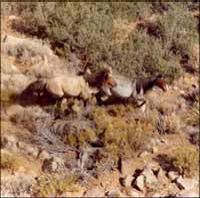Cerbat mustang facts for kids

Cerbat mustangs on the Cerbat HMA, Arizona
|
|
| Distinguishing features | Build is similar to the classic Andalusian horse. |
|---|---|
| Country of origin | United States |
| Horse (Equus ferus caballus) | |
The Cerbat mustang is a special type of feral horse found in Arizona, United States. Feral horses are wild horses that once had owners but now live freely. These horses live in a place called the Cerbat Herd Management Area.
Cerbat mustangs often have coats that are chestnut (reddish-brown), bay (brown with black mane and tail), or roan (a mix of white and colored hairs). They look a lot like the old Colonial Spanish horses. DNA tests show they are indeed related to these Spanish horses. The Spanish Mustang registry even recognizes them as important for their breed. Some Cerbat mustangs can also do a special walking style called an amble.
Contents
What Makes Cerbat Mustangs Special?
Looks and Size
Cerbat mustangs are often compared to the classic Andalusian horse because of their body shape. They usually stand about 14 to 15 hands (56 to 60 inches, 142 to 152 cm) tall. This means they are about 56 to 60 inches (142 to 152 cm) high at the shoulder. They typically weigh around 750 to 800 pounds (340 to 360 kg).
When they were first brought into captivity, some were a bit smaller. They stood about 13.2 hands (54 inches, 137 cm) tall.
Coat Colors and Markings
The most common colors for Cerbat mustangs are bay and roan. You can also find some gray, black, sorrel (a type of chestnut), and dun horses in the wild. Horses kept by people are usually bay, roan, or chestnut.
It's common for these horses to have white markings on their legs and faces. A cool fact about roan Cerbat foals is that they are born roan. Other roan foals might be born dark and then get their roan color as they grow older.
Temperament and Gaits
Cerbat mustangs are known for being calm, quiet, and smart. Some of them can perform special walking styles called intermediate ambling gaits. These gaits are smoother than a regular trot.
Rarity and Registry
Today, these wild horse groups are found in Arizona. The Spanish Mustang registry accepts them because of their history. There isn't a separate official registry just for Cerbat horses right now. They are quite rare. Only about 45 are registered, and around 70 still live wild in the Cerbat Herd Management Area.
History of the Cerbat Mustang

The Cerbat mustang gets its name from the Cerbat Mountains in Arizona. This is where their wild herds live. Many people think these horses are descendants of Colonial Spanish horses. These Spanish horses were brought to a place called New Spain in the 1500s. New Spain included parts of what is now the Southwestern United States.
Other ideas suggest they arrived in the 1700s. Or maybe they were left behind by ranchers in the early 1800s. However, blood tests have confirmed they are indeed related to Colonial Spanish horses. Cerbats are often described as looking like "classic Andalusian" horses. Records show that Cerbat herds were already well-established by 1860.
In 1971, the number of Cerbat mustangs dropped a lot. This happened during a drought. Some ranchers shot many free-roaming horses. They thought the horses were taking water away from their cattle. About 18 Cerbat mustangs were saved during this time. They were captured and kept safe in private herds.
Later, about 20 horses were found still living in the area. In 1990, the Bureau of Land Management (BLM) found another group of wild Cerbat horses. Blood tests showed they were related to the horses saved in private herds. To keep the bloodline strong and avoid inbreeding, male Cerbat mustangs in captivity have been bred with mares from other Spanish-ancestry mustangs.
What Cerbat Mustangs Are Used For
Cerbat Mustangs are very versatile horses. People use them for many different activities:
- endurance riding (long-distance rides)
- eventing (a competition with three parts: dressage, cross-country, and show jumping)
- trail classes (showing how well a horse can handle obstacles on a trail)
- ranch and cattle work (helping with farm tasks and moving cattle)
- team penning (working with a team to separate cattle)
- roping (a rodeo event involving roping cattle)
- Other western competitions

